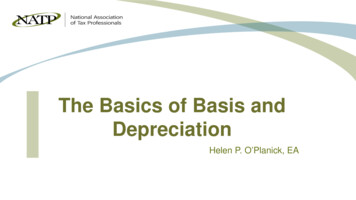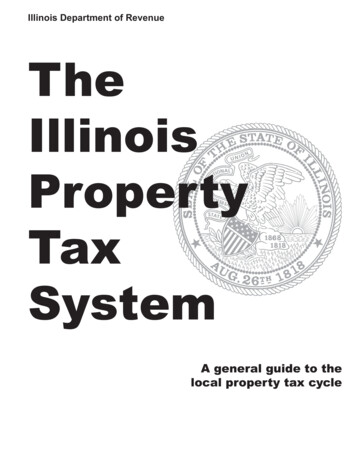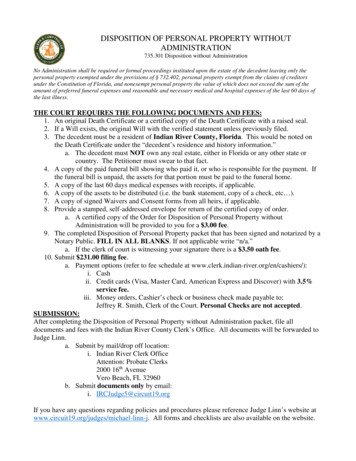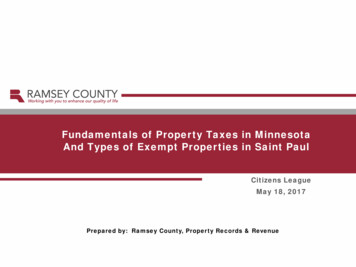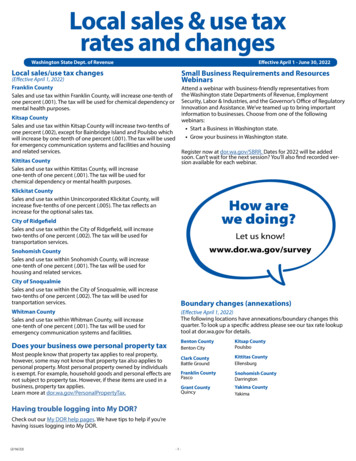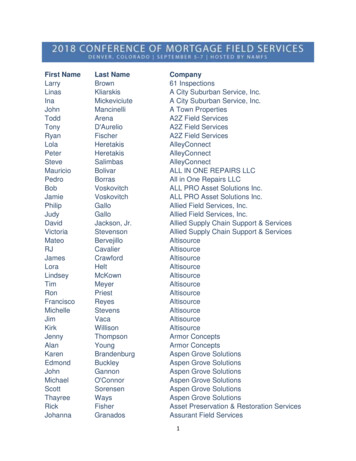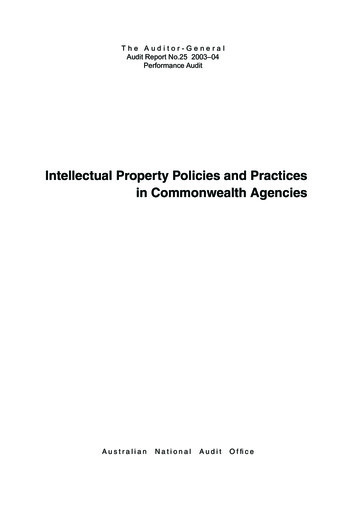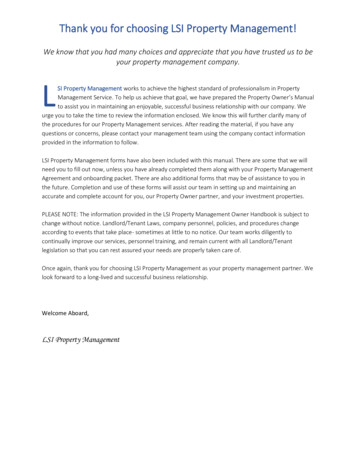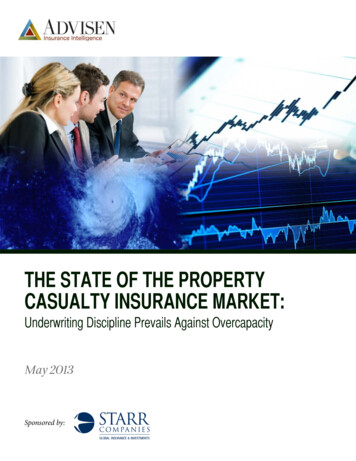
Transcription
THE STATE OF THE PROPERTYCASUALTY INSURANCE MARKET:Underwriting Discipline Prevails Against OvercapacityMay 2013Sponsored by:
The State of the Proper ty Casualty Insurance MarketWHITE PAPERTHE STATE OF THE PROPERTY CASUALTYINSURANCE MARKET:Underwriting Discipline Prevails Against OvercapacityExecutive SummarySlowly but steadily rising premiums characterize the current commercial property/casualty rateenvironment. Insured loss estimates for Superstorm Sandy now are running well in excess of 20 billion, meaning that Sandy likely will trail only Hurricane Katrina as the most costly U.S.storm. The property/casualty insurance industry, however, has taken the hit in stride: losses havenot been sufficient to propel the type of broader market correction seen in 2001 and prior hardmarkets.As of the end of 2012, the average commercial lines premium had increased 2 percent sincerates began creeping upward in the third quarter of 2011, according to Advisen’s ADVx Composite Premium Index. Underwriting losses, low interest rates, rising demand for insurance capacity and the impact on capacity resulting from the adoption of the RMS 11 catastrophe modelall have been suggested as contributing factors in the upward pricing trend. Conditions do not appear ripe for asharp and sustained turn in the pricing cycle, however. Policyholders’ surplus – a measure of insurance capacity – isat a record high, which is a scenario that typically is associated with a highly competitive market.In the absence of major catastrophe losses, insurance buyers can expect current conditions to prevail through theremainder of 2013. The forecast for 2014 is far less certain. A steadily improving rate environment in 2013 is likely toattract new capacity to an already well capitalized market, potentially triggering a new round of competition. Conditions, however, are likely to vary by market segment.Overview of the property/casualty insurance industryThe global property/casualty insurance market was battered by near-record catastrophe losses in 2011. While stillabove the ten year average for catastrophe losses, 2012 was a comparatively moderate year, with a correspondingimprovement in profitability. According to the Property Casualty Insurers Association and ISO/Verisk Analytics, theindustry posted a combined ratio of 103.2, down from 108.1 the previous year, and a 5.9 percent return on averagesurplus. Policyholders’ surplus rose to a record 586.9 billion.Improved profitability combined with record policyholders’ surplus typically would be a recipe for a highly competitive marketplace, but thus far the rate rally that began the fourth quarter of 2011 continues unabated, according toAdvisen’s ADVx premium index. While average rate increases are moderate, every quarter since Q4 2011 hasseen an uptick. Rate changes vary by line of business and market segment, but the general trend towards higherrates is largely consistent across the property/casualty market. At this point in time, underwriting discipline appearsto be overcoming the stiff headwinds of overcapacity.2May 2013 ADVISEN LTD.Sponsored by:
The State of the Proper ty Casualty Insurance MarketWHITE PAPERCapacity and pricingSince capacity, asrepresented by surplus, isat an all-time high, thereshould be significantdownward pressureon rates.That the insurance pricing cycle exists is undisputed. Why it exists remains a matter of debate. Given that there hasbeen a pricing cycle for as long as there has been a regulated insurance industry, it is perhaps surprising that thereis no universally accepted explanation as to why pricing is cyclical. One widely accepted theory is called the capacity constraint theory. It asserts that negative net worth shocks caused by such things as large natural catastropheslead to rapid price increases (a hard market), which then erode slowly as net worth adjusts (a soft market).The capacity constraint theory is essentially an application of supply-and-demand economics. When the supplyof insurance capacity increases faster than the demand for that capacity, prices fall. Conversely, when supplyconstricts relative to demand, prices increase. Major events such as natural catastrophes can rapidly deplete policyholders’ surplus, causing capacity (and therefore supply) to constrict and premiums to rise. As policyholders’surplus is replenished, supply grows and premiums fall.The Advisen ADVx Composite commercial lines pricing index, shows the change in the average commercial linespremium by quarter beginning the first quarter of 2001 (Q4 2000 100). Typical of the commercial lines pricingcycle, the average premium increased sharply for a few years (2001-2004), and then fell at a more moderate paceuntil the third quarter of 2011. Over the past year it has been slowly inching upward.The market peaked at about 153 in thesecond quarter of 2004, meaning thatthe average commercial lines premiumshot up more than 50 percent betweenthe fourth quarter of 2000 and the secondquarter of 2004. The value at the secondquarter of 2011 was 122.1, and has sincecrept to 124.6 as of the fourth quarter of2012.The current period of rising premiums – even though at a moderate pace – seems to defy the capacity constrainttheory. Since capacity, as represented by surplus, is at an all-time high, there should be significant downward pressure on rates. The most likely explanation for rising rates in this environment is that the combined impact of a numberof factors unrelated to the volume of policyholders’ surplus is putting sufficient upward pressure on premiums toovercome, at least for the moment, the influence of overcapacity. Some of the factors that may be exerting upwardpressure include: Underwriting losses. The U.S. P&C industry posted a 16.7 billion underwriting loss in 2012. While sharplylower than the 33.6 billion underwriting loss of 2011, insurance executives agree that an underwriting profit isnecessary to produce an acceptable return in the current low interest rate environment. Low interest rates. Investment returns on the assets held by insurers are a critical component of insurer profitability. In the current low interest rate environment, lower investment income puts pressure on insurer results.According to a Swiss Re analysis, a percentage point decline in interest rates lowers property & casualty insurers’ return on equity by about 2 percentage points.1 Bond yields continued to decline in 2012. Insurers’ netinvestment income, comprised of interest payments from bonds and stock dividends, fell 3 percent to 47.7billion from an already low 49.2 billion for the full year 2011.3May 2013 ADVISEN LTD.Sponsored by:
The State of the Proper ty Casualty Insurance MarketWHITE PAPERDespite underwriting nesses scaled back or closed their doors altogether. Premium written by U.S. insurers fell in .6 percent 2007,losses and low interest1.3 percent 2008 and 3.7 percent 2009.2 As the economy recovers, demand increases, which should putrates, the industrycontinues to be profitable.Increased demand. The demand for commercial lines insurance capacity fell during the recession as busi-upward pressure on prices. At the present time, however, the growth in insurance capacity, as measured bypolicyholders’ surplus, is largely offsetting the impact of increasing demand. Impact of RMS 11. Some insurance industry executives have suggested that adoption of the influential RMS11 catastrophe model has effectively reduced the capital to support underwriting activities even though therehas been no reduction in actual policyholders’ surplus. Under RMS 11, expected losses for many hurricanescenarios increased. The model implies that insurers and reinsurers need to allocate more capital to hurricaneexposed business, thereby reducing the capital available to support other lines of business. RMS 11, however,has not been universally and unequivocally adopted by the P&C industry, and this factor alone seems unlikelyto account for pricing increases.These and other factors encourage underwriters to push pricing higher, but the question remains whether rateincreases are sustainable for a prolonged period. The jury is out, but the verdict probably is “no.” Despite underwriting losses and low interest rates, the industry continues to be profitable: the return on average surplus was 5.9percent during 2012. Considering that the industry is also overcapitalized by some measures, underwriters may findit difficult to continute to raise rates. This will especially be the case as an improving rate environment attracts newcapacity to the market, as already is beginning to take place.Other factors and market developmentsBeyond rate levels, a number of other factors and developments characterize and influence current market conditions.Uncertain impact of healthcare reformDespite continued challenges, it is nearly certain that the roll out of the Patient Protection and Affordable Care Actwill continue as scheduled. Signed into law on March 23, 2010, the 906-page piece of legislation represents mostsignificant regulatory overhaul of the U.S. healthcare system since the passage of Medicare and Medicaid in 1965.Healthcare reform already is having an impact on the liability exposures of healthcare organizations and providers.Many of the most significant exposures are related to new collaborative healthcare delivery models such as theMedicare Accountable Care Organization enabled by the Act.Healthcare reform affects more than just medical professional liability exposures. Cyber liability exposures, for example, are growing as the push for electronic medical records outpaces improvements in network security at mosthealthcare organizations. Many insurers serving the healthcare sector now are reviewing their policy forms andunderwriting criteria.Insurers and risk managers also are grappling with other potential changes in exposure resulting from healthcarereform. It is likely that reform will have an impact on medical costs – presumably for the better, though nothing is certain at this point. This could have a material influence on liability lines, especially workers’ compensation. A RANDstudy based on the experience of Massachusetts, which implemented a health care reform package with provisionssimilar to those in the Affordable Care Act, found that found that workers’ compensation billing frequency for bothemergency room visits and inpatient hospitalizations fell by 5 to 10 percent as a result of reform, but that billedcharges and treatment volume were not measurably affected.34May 2013 ADVISEN LTD.Sponsored by:
The State of the Proper ty Casualty Insurance MarketWHITE PAPERGrowth in surplus linespremium also is likelyto be influenced by theNonadmitted andReinsurance Reform Actof 2010Workers compensation market improvementsWorkers’ compensation results and issues vary widely by state. Overall, workers’ compensation has been one of themost distressed P&C lines over the past several years, culminating with a 115 combined ratio in 2011. The situationappears to be improving, though. The NCCI, in its recently released annual State of the Line report, characterizedthe market as “encouraging,” with the 2012 combined ration coming in at 109, the first decrease since 2006. Premiums are rebounding from the ravages of the recession, and lost-time claim frequency improved significantly — down5 percent on average in NCCI states. The NCCI warns, however, that significant challenges remain due to persistent(though decreased) underwriting losses, low investment yields, and continued uncertainty regarding the impact ofthe implementation of the federal healthcare reform bill.4Surplus lines market slowly reboundingSurplus lines carriers typically experiences premium erosion in the soft phase of the cycle. As admitted insurersexpand their risk appetites and broaden their underwriting criteria, business flows in from the non-admitted market.According to a report issued by the Surplus Lines Stamping Office of Texas, the number of filings processed bystamping offices through June 2012 decreased slightly compared with the first half of 2011, though written premiumincreased. This implies that the surplus lines market, as of this time last year, was benefitting from higher rates, butnot from an increase in the volume of business written.5 The Texas stamping office has not updated its figures sinceJune 2012, but anecdotal evidence suggests that business has now begun to trickle back into the surplus linesmarket. As the market firms and premium volume increases, standard lines insurers are less inclined to fish in thesurplus lines pond. A full-fledged hard market would trigger a surge of premium back into the non-admitted marketfrom the standard market. Growth in surplus lines premium also is likely to be influenced by the Nonadmitted andReinsurance Reform Act of 2010, a section of the Dodd-Frank Wall Street Reform and Consumer Protection Actwhich, among other things, eases access to the market for large insureds.A renewed focus on terrorismThe tragic Boston Marathon bombing has turned the spotlight on terrorism insurance. Many local businesses did notpurchase the coverage, and likely will not have insurance available if the occurrence is labeled a terrorist event bythe federal government. More broadly, the event has sparked discussions about federal terrorism insurance protection, and the fact that the Terrorism Risk Insurance Program Reauthorization Act, is set to expire on December 31,2014. A bill introduced into the House of Representatives would extend federal protection by 10 years, but passageis far from certain. The issue already is having an impact on some segments where coverage periods extend beyondDecember 31, 2014. It is likely that many insurers would likely scale back their terrorism insurance offerings, or evenstop selling policies altogether, if the law is allowed to expire.Cyber liability emerges as a significant new productCyber liability is one of the few segments of the commercial insurance market to have shown strong growth in recentyears, with significant potential for yet more growth. Advisen estimates that, once fully mature, the cyber liability market will represent about 4 billion in written premium. At present, the market is less than one quarter of that. Growthhas been driven in large measure by data breach notification laws, which have now been passed in 46 states. Thedesire to take advantage of this explosive market already has attracted nearly 40 carriers in the U.S., according toAdvisen Market Insight data. A number of observers have noted similarities between cyber liability and the growthof the employment practices liability (EPL) insurance market. Once a difficult sell for agents and brokers, EPL is nowconsidered an essential insurance purchase by many organizations.5May 2013 ADVISEN LTD.Sponsored by:
The State of the Proper ty Casualty Insurance MarketWHITE PAPERInsurers and reinsurersare looking tofast-growing emergingeconomies in Asia, LatinThe impact of globalizationInsurers and reinsurers are looking to fast-growing emerging economies in Asia, Latin America and Eastern Europeas engines of growth. A recent report from Munich Re forecasts that growth in insurance and reinsurance in emerging countries will be significantly stronger than in industrialized countries though at least 2020, with the strongestgrowth expected in Asia.6 A survey of insurance equity analysts by Accenture found that an emerging market expansion strategy is perceived as critical to earning a “Buy” rating.7 Large insurers also are finding it competitively essen-America and Easterntial to have a global presence to meet the needs of their multinational clients. Not only do clients expect their insurersEurope as engines ofto provide appropriate coverage as they grow, many look to them for advice as they expand into unfamiliar locations.growth.A growing focus on supply chain risksAn area that has received increased attention from risk managers and insurers is supply chain vulnerability, whichwas highlighted by the 2011 Tohoku earthquake and tsunami in Japan and floods in Thailand. A combination ofjust-in-time inventory management and supply chains stretching around the world left many manufacturers scrambling to maintain production schedules in the wake of these events. More companies now are focused on buildingresiliency into their supply chains. Underwriters are paying much more attention to contingent business interruptionexposures, and policy wordings have changed in many cases to reflect lessons learned from the events.Planning for 2013 and beyondNOTES:Rate increases have been occurring for more than a year in an environment where, by some theories, they shouldn’t1be. The property/casualty insurance industry is extremely well capitalized, which typically would encourage under-Global Insurance review and outlook2011/12, Swiss Re, December 2010, p.62writers to vigorously compete to put excess capital to work. Instead, underwriting discipline prevails. While excess“2009 - Year End Results,” III htmlcapacity may eventually lead to renewed rate competition, insurance buyers should plan on continued upward3pressure on rates at least through 2013.Paul Heaton, The Impact of Health CareReform on Workers’ Compensation MedicalCare: Evidence from Massachusetts, RANDhttp://www.rand.org/pubs/technical reports/TR1216.html4While the overall trend is towards higher premiums, risk managers report that underwriters generally are willing to“NCCI Releases Annual Workers’ Compensation Market Analysis,” NCCI -annual-workers-compensationmarket-analysis/take into account material factors that differentiate one account from another. Risk managers who are able to dem-5ket segments that respond to conditions specific to each segment. While the pervasive trend is towards gradually“Stamping office statistics show increased rates in surplus lines rance.com/article/20121007/NEWS07/310079996?tags 311 303#Numbers exclude New York, which wouldhave distorted the results due to a high volume of prior year filings processed in 2011.6“Munich Re expects strong insurance sector growth until 20o” http://www.munichre.com/en/media relations/press releases/2013/2013 05 16 press release.aspx7“Equity Analysts Expect Higher Profitability from Insurers Despite Difficult MarketConditions, According to Accenture Survey,” Accenture urvey.htmonstrate why their programs represent a better-than-average risk say that they have been able to renew at essentiallyexpiring terms. It also should be kept in mind that the property/casualty market is the aggregation of numerous mar-but steadily rising rates, some segments vary.The outlook for 2014 is clouded by a number of factors. One significant variable is new capacity entering the marketto take advantage of an improving rate environment. In a market that has been characterized as “awash in capital,”additional capacity could challenge the ability of underwriters to continue to nudge rates upward.Of course, the wild card every year is catastrophe losses. A single mega-catastrophe, or a series of smaller events,could destroy sufficient surplus to send rates higher. NOAA’s Climate Prediction Center is forecasting an active orextremely active hurricane season this year. However, it should be kept in mind that the insurance industry hasproved to be remarkably resilient. Back-to-back record-shattering years of hurricane losses in 2004 and 2005, andnear-record catastrophe losses in 2011 had almost no long-term impact on rate levels. Given the current level ofcapitalization of the insurance industry, it would likely require unprecedented losses to trigger the type of hard market last seen in 2001, when the average commercial P&C premium for large accounts surged more than 50 percent.6May 2013 ADVISEN LTD.Sponsored by:
The global property/casualty insurance market was battered by near-record catastrophe losses in 2011. While still above the ten year average for catastrophe losses, 2012 was a comparatively moderate year, with a corresponding improvement in proitability. According to the Property Casualty Insurers Association and ISO/Verisk Analytics, the



